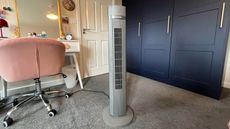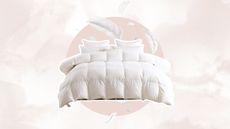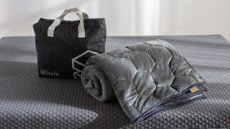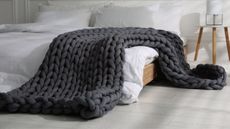Bedrooms
The latest Bedrooms breaking news, comment, reviews and features from the experts at Realhomes
Explore Bedrooms
-

What is the Scandinavian sleep method? The pros explain this unusual duvet hack
Sleep experts dive into the pros and cons of the game-changing technique
By Eve Smallman Published
-

Lindsay Lohan's bedroom is a serene coastal haven — designers say it’s “tranquil and inviting”
We love Lindsay Lohan's nursery, which offers plenty of bedroom inspiration for kids' rooms and beyond. We ask interior pros why the space works so well
By Eve Smallman Published
-

6 of the best mattress protectors to buy — budget, organic, and cooling options from $12.99
See six of the best mattress protectors, from Casper, Avocado, and more — tried and tested by us. Plus budget-friendly and highly-rated options
By Christina Chrysostomou Last updated
-

9 best bedding brands to buy including budget and eco-friendly options
Take your sleep set-up to the next level with the best bedding brands to buy including affordable options and eco-friendly, organic buys
By Annie Collyer Last updated
-

6 of the best affordable pillows, tested by up and highly-rated by shoppers from $3.50
According to our sleep experts, some of the best affordable pillows can feel just as premium as higher-end head supports
By Christina Chrysostomou Last updated
-

Best bed sheets, as reviewed by us and rated by shoppers — 12 of the top picks starting at $9.50
We found the best bed sheets, loved by us and shoppers alike. We tried out these sets with linen, cotton, bamboo, and microfiber options
By Annie Collyer Last updated
-

Best weighted blankets for your best sleep ever — 5 tried and tested buys
Discover the best weighted blankets to help relieve anxiety, stress and sleep problems. We tried these buys for weeks to see how they hold up
By Jaclyn Turner Last updated
-

Best cheap bedding sets — top-rated picks starting at $27.95
I found the best cheap bedding for under $100, including sheets and comforter sets. These options are all highly rated and loved by shoppers
By Emily Lambe Last updated
-

Best duvet inserts and comforters for year-round use — 6 buys tried and tested by us
We tested the best duvet inserts from the likes of Brooklinen, Buffy, and Saavta so you can get your best sleep whatever the temperature
By Annie Collyer Last updated
-

7 inspiring coastal guest bedroom ideas for a serene seaside retreat
Here's how to craft the perfect coastal guest bedroom for your visitors, with top tips from our panel of experts. See our nautical-inspired design ideas
By Isabella Charlesworth Published
-

Best linen sheets — 6 editor-approved buys for your coziest bed ever
These are the best linen sheets, tried, tested, and recommended by a Real Homes sleep expert from Cultiver, Piglet in Bed, and more
By Jaclyn Turner Last updated
-

Best bamboo bed sheets — 9 sets tested by us and loved by shoppers
These bamboo bed sheets from Amazon, ettitude, and other brands are the softest in the bedding game, with benefits that go beyond being eco-friendly
By Louise Oliphant Last updated
-

The Pelonis tower fan is my summer sleep savior
I don't have the luxury of AC at home so I really on fans to keep cool. The Pelonis tower fan on Amazon has been my key to summer sleeping
By Punteha van Terheyden Published
-

Get the Nectar mattress for its lowest price ever
Don't sleep on this Nectar mattress deal
By Eve Smallman Published
-

12 of the best Amazon queen bed frames — starting from under $100
Your answer to a great night's sleep starts with these Amazon queen bed frames. They start from $84.99 and are highly rated by shoppers
By Joseph Bobowicz Last updated
-

How to create a hotel-style bedroom — 6 clever tips and tricks interior designers always use
Want to find out how to create a hotel-style bedroom? We've asked interior designers and bedding experts for their top tips, plus curated highly-rated picks
By Eve Smallman Published
-

This viral Amazon duvet is perfect for enjoying hotel-luxury at home — and it’s on sale
We love the viral Amazon duvet, so we've tracked it down and found it on sale. Here's why shoppers love it, plus alternatives that we've reviewed ourselves
By Eve Smallman Published
-

Eva Longoria's closet just got a major makeover — see how to organize yours like a pro
See how to recreate Eva Longoria's closet makeover with celeb-approved tips and tricks. Organize everything from sneakers to bags and hats
By Emily Lambe Published
-

How to get hotel bedding at home with advice from the pros and luxe buys
Take your bed to the next level with hotel bedding at home. See which sheets major hotels use and the best way to make your bed into a fluffy oasis
By Emily Lambe Published
-

Layla weighted blanket review — this super soft cooling blanket is a must-have
See what we thought of the Layla weighted blanket after testing it at home. This super soft cooling blanket is a must-have for a sense of calm
By Alex Frost Published
-

This sleep mask with headphones from Amazon has unlocked eight hours sleep a night for me — and it's on sale
We explain why this sleep mask with headphones is amazing, show you where to shop it, speak to sleep pros about the benefits of these, plus pick alternatives
By Eve Smallman Published
-

The Parachute Memorial Day sale has been extended for one day only — 25% off everything and 30% off bundles
See our fave picks from the Parachute Memorial Day sale. The 25% off everything & 30% off bundles discount has been extended for one day only
By Emily Lambe Published
-

The Casper Memorial Day sale is on now with up to 35% off all mattresses
The Casper Memorial Day sale brings big savings on bedding for a limited time. Save up to $375 on the original mattress, plus pillows and bedding bundles
By Emily Lambe Published
-

Best mattress sales — where to shop Memorial Day deals on now
Deals Save hundreds of dollars by shopping for the best mattress sales. See Memorial Day deals on Casper, Purple, and more
By Emily Lambe Last updated
Deals -

How heavy should a weighted blanket be?
We asked the experts how heavy should a weighted blanket be. See what to look for and what weight is right for you when shopping for this cozy essential
By Heather Bien Published
-

Why does my bedroom smell musty? Cleaning experts offer insight and solutions to creating a fresh space
If you're curious, "Why does my bedroom smell musty," our cleaning pros will point you towards potential culprits and solutions.
By Danielle Valente Published
-

Experts reveal 8 weighted blanket benefits including reduced anxiety, insomnia and boosted serotonin
Discover weighted blanket benefits such as reduced anxiety, increased focus, reduced movement in the night and better focus in the day
By Heather Bien Published
-

Shoppers approve of this Wayfair cooling mattress on sale now for less than $270
See the Wayfair cooling mattress with over 18k reviews and 4.6 stars for summer sleeping. Plus, more cooling sleep essentials on sale now
By Emily Lambe Published
-

How to zone a bedroom — 7 tips for "maximizing space" and "elevating design" that design pros swear by
Want to know how to zone a bedroom? We've asked design experts how you can lay out this space properly, plus picked out useful buys to match
By Eve Smallman Published
